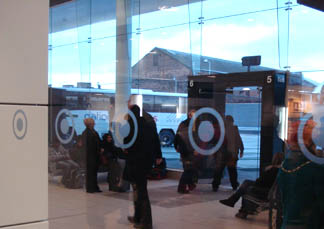- Robert Colbourne
- About
- Working
- Loading Bay Pocket Park
- Exchange
- 29-32 Mary Street
- King Edward VI Sixth Form College
- Tamed [Flood Management Scheme]
- Smithfield Site
- Frames - King Edward VI College
- James Watt Campus, Birmingham Metropolitan College
- Kemble Airfield
- Fargo
- Woodthorne Residential Housing Development
- Muchall Grove Housing Development
- Gravesend
- Meshwork Worcester
- Quadrant, Network Rail National Centre
- 20ft to an Inch [Sustrans]
- Birmingham Coach Station, Digbeth
- South Wolverhampton and Bilston Academy
- Longton Plots
- Pride of Place, West Bay
- Darwin Hall
- Light in Benmore - Optima Housing Association Art-as-Maintenance Report
- Smithfield 1 Proposal
- Interchange
- Turning Wall
- Springfield Brewery
- Constellations, Optima Housing Association
- AFC Telford United
- Stourport Day Book
- Stourport markers
- Changing Landscapes
- Rea Park, Digbeth
- Rea Crossing, Digbeth High Street
- Green Bridge Feasibility Project
- BryantPriestNewman 10
- Longhouse CPD, Confluence and Mythe
- Landscapainting
- Rd
- At any specific
Balance/Flow, Birmingham Coach Station, Digbeth, Birmingham [2008-9]
Public art scoping/ plan and 'boundary' fence design and implementation. Joint lead artist with Stuart Mugridge, collaborating with SBS Architects, Xtraweld and CIES Electrical Services.
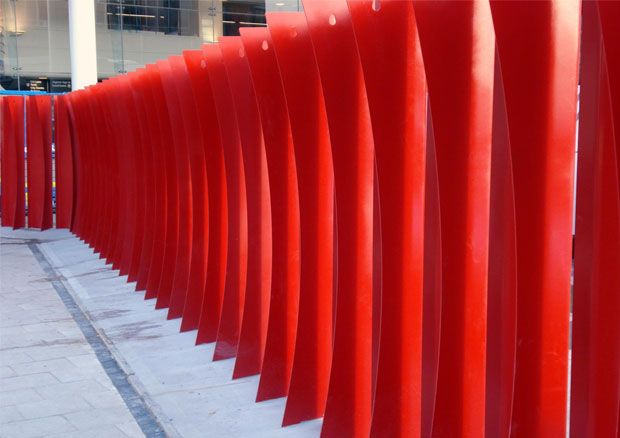
'Art not separate from experience...environment is a process of interaction' (Kaprow, Allen. 'Essays on the Blurring of Art and Life' University of California Press, Ltd. 1993, 2003)
Initial scoping and plan
An extensive investigation into the wider area of Digbeth became focused on the immediate site occupation and activity. As early as the 16th Century it was occupied by the Askerisk's mill, powered from a leat of the river Rea and associated with both fulling and slitting. In the 19th century W and T Avery manufactured an assortment of weighing apparatus, including steelyards and ticket printing weighbridges. In 1929 the Birmingham and Midland Omnibus Company Ltd. opened a bus depot on the site, later becoming simply known as 'Midland Red'. Most recently the coach station became a large influence of the character of Digbeth and synonymous with the influx of the Irish community and their strong presence in the area
This research, community consultation, existing local knowledge, local authority policy documents, site visits and investigation reports became distilled into an overarching theme of 'Balance/flow'. This was an umbrella for a varied family of proposals that integrated within the everyday tasks, processes and physical landscape of the whole station. It became a collection of ideas for colour and materiality, form, natural and artificial light, surfaces, signage, ephemera and publications, performance, contrasts and juxtapositions, movement, connectivity and perspectives, that hoped to provoke both intrigue into Digbeth and affirm the station's identity, inducing a particular sense of arrival in and departure from Birmingham
The Boundary Fence
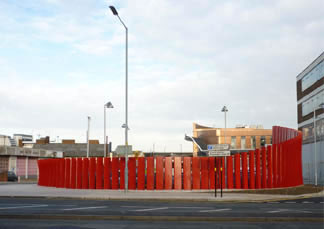
The design followed the ethos of 'opening up' the site, exposing industrial 'haunch' forms that echoed the interior of the previous station and 19th century engineering. The individual forms themselves balance on varying tipping points of physical and visual weight, whilst collectively creating a fence that induces particular senses of direction and movement. The lack of a horizontal component creates a sense of visual access through vertical gaps or slits, which also positively reinterpret glimpses of hidden workshops, factories and restricted land in the Digbeth area. In addition a lighting scheme augments the Midland 'red', but also a sense of measurement and distance, influenced by the avoirdupois system.
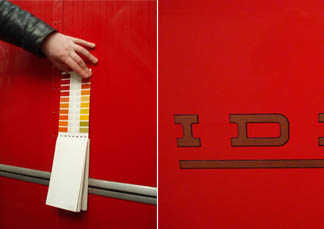
In effect, the fence became a series of related ideas and features, evident of an approach that valued user experience over integrated art 'object'.
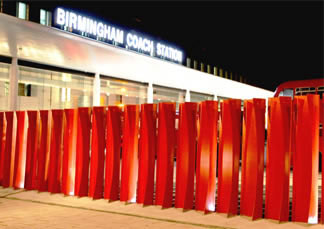
Leopard Spots
Collaborating with Nick Hawksworth from Wayfinding Consultants resulted in subtle glass manifestations echoing Midland Red's garage code or 'leopard spot' for Digbeth.
